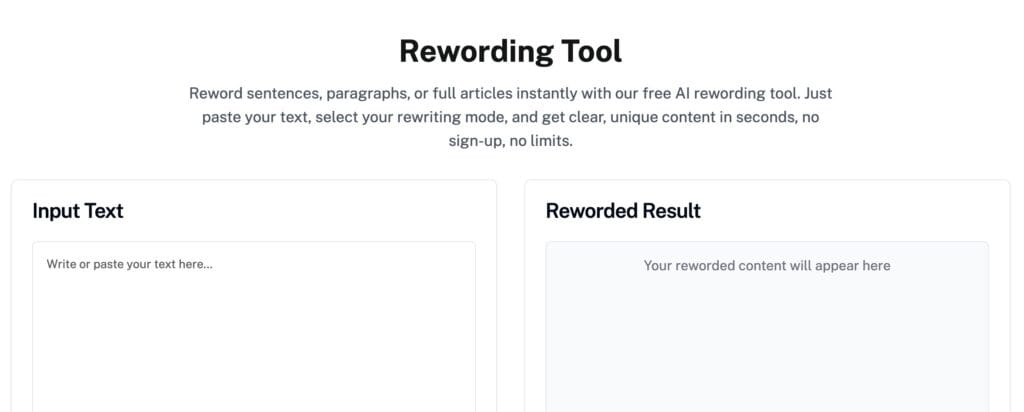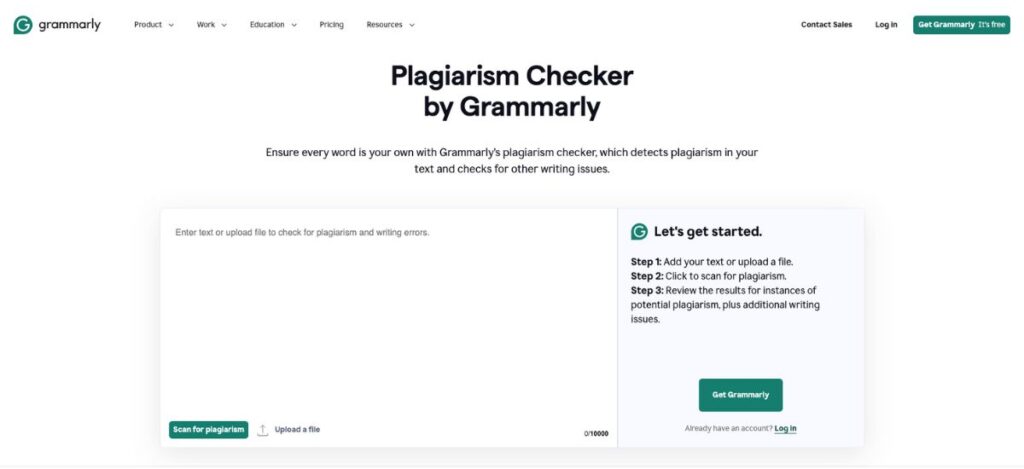Key Terms Defined
| Tool Type | Description |
|---|---|
| Paraphraser | Tools like Quillbot that use natural language processing to rewrite text while preserving its meaning. They analyze syntax and semantics to generate new phrasing and word choices, often used to “translate” dense text into plain language or to avoid plagiarism. |
| Text Humanizer | Tools like Undetectable AI that obscure the AI essence of text by making it mimic human qualities. They use cutting-edge natural language generation (NLG) to add human touches like varied sentence structure, figures of speech, and idiosyncrasies to make AI text appear human-written. |
| Plagiarism Checker | Tools like Grammarly that match text against billions of online sources to detect duplicate or highly similar content. They provide references and citations for flagged passages and help writers uphold integrity. |
| AI Detector | Forensic tools that analyze writing for machine-generated markers. Using natural language processing and machine learning, they generate a percentage score of a text’s perceived “AI-ness”, attempting to judge if a text is human or machine-generated. |
Text analysis tools powered by artificial intelligence (AI) are fast changing how we create, share, and consume digital content.
Understanding these different definitions and modalities, alongside the “why” of why people are using them, is more important than ever before.
Since AI content detectors skyrocketed in popularity, the cases of people getting falsely accused of having used AI is also increasing.


Never Worry About AI Detecting Your Texts Again. Undetectable AI Can Help You:
- Make your AI assisted writing appear human-like.
- Bypass all major AI detection tools with just one click.
- Use AI safely and confidently in school and work.
Now, more people are finding themselves looking for methods to ethically bypass AI detectors, out of fear that their hand written work will get flagged.
Paraphrasers and undetectable AI text humanizers are similar, and while some may think they’re the same, they aren’t. Lets dive in.
Paraphrasers: AI-Enabled Rephrasing
Got a dense bit of text that needs “translating” into plain language… or rewritten to merely avoid the charge of plagiarism? There’s a paraphraser for that!
Paraphrasing tools like Quillbot use natural language processing to rewrite text while preserving its meaning.
The AI scans the text, analyzing syntax and semantics, then generates new phrasing and word choices.
The result is the same content with a fresh lexical facade. Blocks of dense words get broken down into readable, conversational language.
Paraphrasers aim to enhance clarity, not deceive. But their rephrased text usually sounds AI-generated to the discerning eye.
Although generally intended to be used ethically, simple paraphrasers are frequently used to “spin” content, and “de-plagiarize” original works.
When ChatGPT had first released, paraphrasing was used to outwit AI detectors.
But as detection improved, this strategy crumbled. Now paraphrasing often sets off AI detection, rather than evading it.
Quillbot: The OG Paraphraser

Pictured above, Quillbot is a paraphraser that allows you to do things like rewrite up to 6,000 words, and summarize long-form text.
There is a free tier offered, and their premium plan starts at $19.99 a month. Here’s a full breakdown of the pricing, and the free vs premium features of the app.
Quillbot Pricing
- Monthly: $19.95 USD billed monthly
- Semi-Annual (Save 33%): $13.33 USD per month ($79.95 billed every 6 months)
- Annual (Save 58% – Best Value): $8.33 USD per month ($99.95 billed every 12 months)
Quillbot Features
| Feature | Free | Premium |
|---|---|---|
| Words in Paraphraser | 125 words | Unlimited words |
| Modes for Paraphrasing | Standard and Fluency modes | Unlimited Custom and 8 predefined modes |
| Synonym Slider | Limited use | Full use |
| Freeze Words | 1 Freeze Word | Unlimited Freeze Words |
| Words in Summarizer | 1,200 words | 6,000 words |
| Processing Speed | Faster | Faster |
| Recommended Rewrites | Available | Available |
| Compare Modes | Available | Available |
| Plagiarism Checker | Available | Available (20 pages/month) |
| Tone Insights | Available | Available |
| Paraphraser History | Available | Available |
(Source: Quillbot Pricing page)
When Plain Language Counts
Paraphrased content should be carefully reviewed. Nuance can get lost amidst the rephrasing, so it’s key to check that meaning remains intact.
Used strategically, paraphrasers are powerful writing aids. But they aren’t silver bullets for producing human-sounding text. Their robotic touch is hard to hide, and most people use them to merely spin content.
If you’re looking for something more refined than a basic paraphraser — a tool that helps you rewrite text with better flow, stronger clarity, and a human touch — meet our Rewording tool.
It goes beyond just swapping synonyms or reordering phrases. Instead, it reshapes your sentences while preserving your core ideas, improving readability and style without stripping away meaning.

Perfect for students, professionals, and creators who want to elevate their writing, this tool helps you sound more like you — polished, clear, and authentic.
Text Humanizers: Reverse Engineering Readability
What if AI-generated text could pass smoothly as human-written? Meet the text humanizer.
Tools like Undetectable AI obscure the AI essence of text by making it mimic human qualities. This goes far beyond paraphrasing.
The humanizer uses cutting-edge natural language generation (NLG) trained on massive datasets.
It reverse engineers readability, adding nuanced human touches to text like varied sentence structure, figures of speech, and idiosyncrasies.
The goal of the text humanizer is to make AI text pass as legitimately human-created – convincing even robust detection tools that the text is human.
Why? Well some say that text which seems AI-generated isn’t trustworthy, and while part of that is by how it might read or sound, another part is the over reliance and trust of AI-detection tools.
Undetectable AI started off as a way to create higher quality authentic sounding text, but as the demand to bypass AI detectors skyrocketed, the product was further developed to both improve AI-generated text, and specifically circumvent detectors.
As the technology evolves, ethical dilemmas around humanized text will intensify. For now, it remains an impressive capability.
But while such a powerful tool could be abused, tons of emails have come in from people using Undetectable.ai because they want their hand typed original work to pass, because like all tech, AI detectors aren’t perfect.
Unfortunately people constantly get falsely accused of cheating on their assignments (on the basis of their work getting detected as “100% AI”).
Undetectable.ai was designed to be powerful, effective, and ethical
The weaponization of AI detectors by unscrupulous professors and employers has lead to a paradoxical scenario, where all that’s cared about, is an arbitrary score—assigned by AI, after AI supposedly investigated AI.
And now, using a tool like Undetectable has become the only way for some people to “prove” their own content is human.
Plagiarism Checkers: Holding Writers Accountable
Got a nagging feeling that passage sounds familiar? Plagiarism checkers can help sniff out unoriginal work.
By far one of the most popular and well known tools equipped with plagiarism detection is Grammarly.
Tools like Grammarly try to match text against billions of online sources. When a match surfaces, they provide references and citations.

The citations and verifiability of plagiarism are what staunchly separate AI-detectors and plagiarism detectors.
Plagiarism checkers hold writers accountable by detecting duplicate or highly similar text. This makes them a more objective tool than AI detectors.
Matches can be verified by cross-checking the flagged passage with the identified source. This leaves little to no ambiguity.
However, these checkers are fallible. Rare word collisions can generate false positives. And with billions of webpages in the mix, they can miss matches too.
For writers, plagiarism tools help uphold integrity. But like all software, human oversight is needed to confirm results.
When a plagiarism detector generates a false hit, it’s easy to check the citation, and identify such instances. This is not the same with AI detection currently.
AI Detectors: Judging Human vs. Machine
If a text’s humanity is in doubt, AI detectors aim to crack the case.
How AI Detectors Work
AI detectors analyze writing for machine-generated markers. Using natural language processing and machine learning, they generate a percentage score of a text’s perceived “AI-ness.”
The detectors are trained on human-verified corpora to learn the hallmarks of both real and artificial writing. With this data, they try to spot subtle giveaways like repetition, syntax, and formulaic patterns.
Unlike plagiarism checkers, results are probabilistic.
There’s room for error judging human versus machine. Another controversial aspect, adding to the lack of objectiveness, is that many AI detectors claim to train on ChatGPT data.
Recently, OpenAI has been the target of various lawsuits from people claiming ChatGPT trained on THEIR data. Ironic right?
Yet the consensus from most people seems to be that these ChatGPT detector tools help screen questionable content.
Yet the truth seems obvious: human discernment plays the most important role in the finality of determining these things.
“AI-giarism” – Sensational Label, or Valid Concern?
As AI text generation heats up, a controversial term has emerged: “AI-giarism.”
AI-giarism almost sounds… like a made up word? But thats because: It is.
But What is “AI Plagiarism”?
It’s a new word some have unironically used, but more prominently, it represents the current state of misinformation surrounding AI detection; that is, that an AI-detection score = a plagiarism score.
This alleged fusion of “AI” and “plagiarism” gained traction following the launch of ChatGPT and other generative writing tools.
Critics argue the AI’s original-sounding output potentially plagiarizes published work. Others countered that the term exaggerates misconduct related to AI writing assistance.
For instance, people who use a grammar improvement tool, like grammarly, are at risk of having their work flagged as that of a dirty rotten AI-giarizer.
Upon inspection, AI-giarism conflates two different distinct issues.
Merely using an AI tool is not inherently plagiarism. But knowingly passing a completely generative output as one’s own could be considered unethical.
For writers, thoughtful citations, and required disclosures, beyond certain levels of AI use is key. Transparency and ethics are important.
As AI capabilities grow, we need nuanced debate, not exaggerated rhetoric, around proper usage. Clarity of language will lead to clarity of action.
Looking Ahead: The View from 2024
One thing is constant: there is no substitute for the virtues of accuracy, transparency and integrity. Technology simply surfaces new challenges in upholding these timeless values.
AI will keep advancing. But by staying meticulous, skeptical and honest, writers can navigate the text analysis toolbox judiciously.
And readers worldwide will benefit. For innovative technology always works best when guided by informed and ethical human hands.
A Final Word From The UD Team
We won’t stop bypassing detectors until humans stop getting falsely accused— and even then, our goal is to give small businesses, freelancers, and under-equipped individuals the power to leverage AI in their workflow in such a way that provides a competitive edge; which in the end—looks like high-quality AI-copy indistinguishable from human written text.
Some people can’t afford a copywriter for their blog. Some people struggle to write emails—regardless of one’s disadvantages, we believe everybody deserves an equal shot at succeeding, and should not be bound to the voice or sound of artificiality.
After all, the people using it are PEOPLE. We believe that people should be treated equally, and when one group is affected by an unequal distribution of ability (financial or otherwise), we believe such groups possess an inherent license to level the playing field—that they may, with equality, engage in the pursuit of access and success.
Join the growing community of educators and students who trust Undetectable AI.
Use the widget below (English only) – simply paste your text and see how easily you can detect AI-generated content.
Try it for FREE today and ensure academic integrity in your institution.
